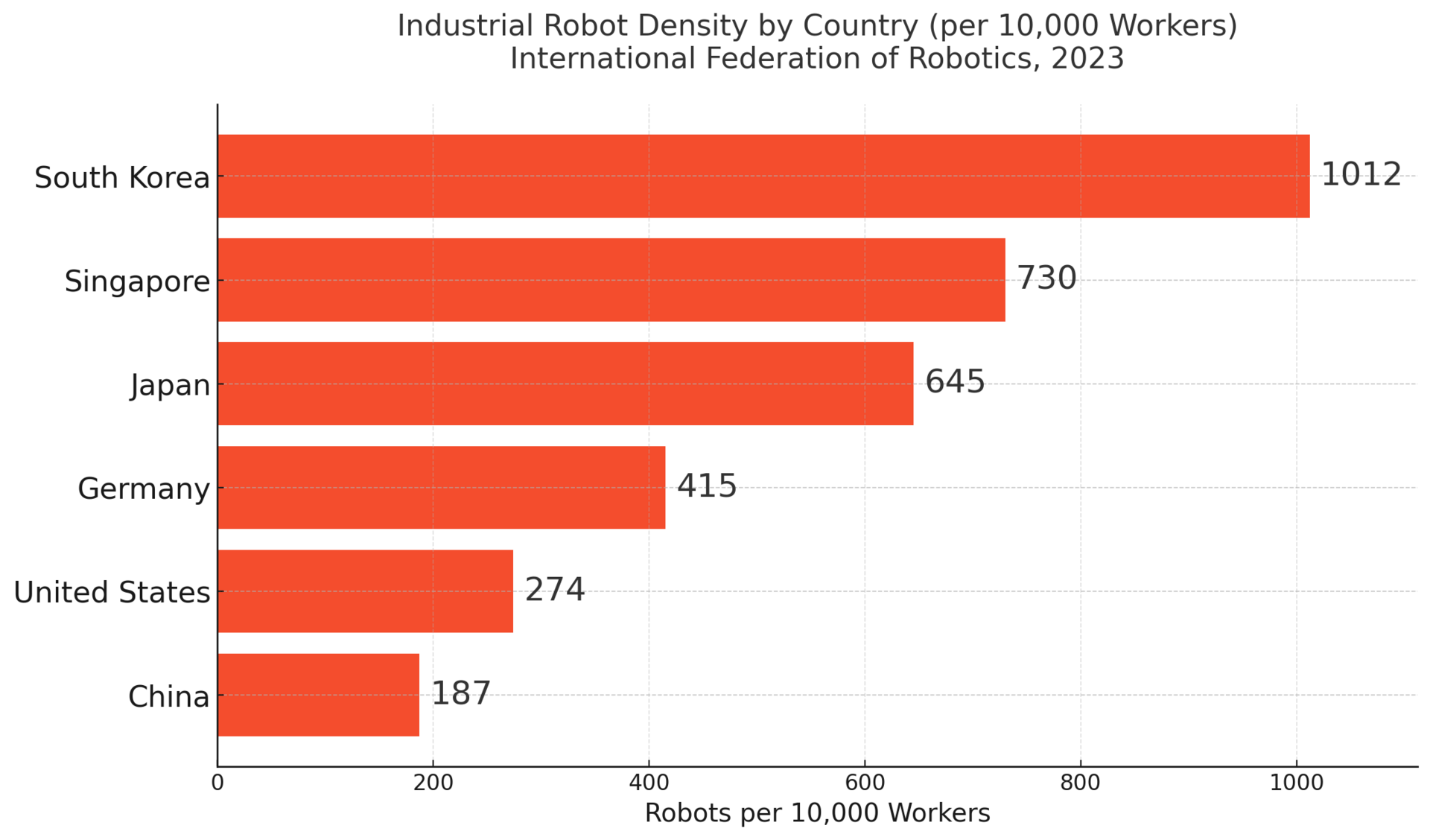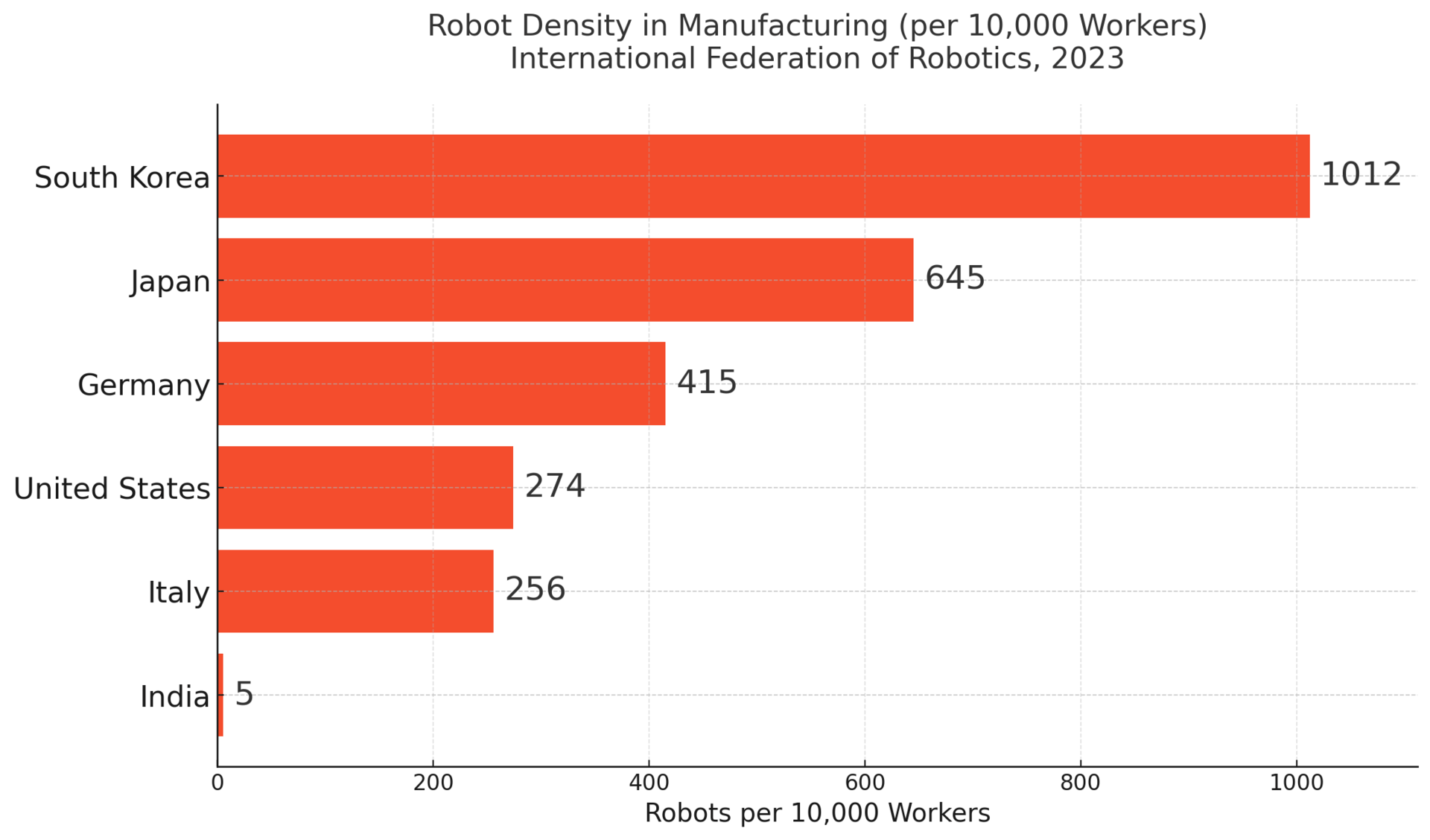- World Population Review Newsletter
- Posts
- Robots Rising: 6 Nations Replacing Workers Fast
Robots Rising: 6 Nations Replacing Workers Fast
Who's leading, who's lagging—and what it means for your future.
Greetings, future-focused thinker!
Robots are no longer coming—they’re here, and they’re changing everything. From factories to finance, automation is rewriting the rules of work, wealth, and where opportunity lives.
This edition dives into the countries adapting fastest—and what it means for your next move, investment, or strategy.
Let’s decode the global automation race.
Tech moves fast, but you're still playing catch-up?
That's exactly why 100K+ engineers working at Google, Meta, and Apple read The Code twice a week.
Here's what you get:
Curated tech news that shapes your career - Filtered from thousands of sources so you know what's coming 6 months early.
Practical resources you can use immediately - Real tutorials and tools that solve actual engineering problems.
Research papers and insights decoded - We break down complex tech so you understand what matters.
All delivered twice a week in just 2 short emails.
No country has embraced automation more eagerly—or out of more urgent necessity—than Japan.
Facing one of the fastest-aging populations on Earth and a shrinking workforce, Japan didn’t just flirt with robotics; it married them. With over 400 robots per 10,000 workers, it boasts the highest robot density in the world. From factory lines to elder care, automation is not just about efficiency—it’s about survival.
Japan’s government has actively supported this transition, offering tax incentives for robotics adoption and even promoting robot-human social interaction in care facilities. The result? Productivity has remained stable even as the population declines.
📌 Little-known insight: In some rural prefectures, robotic exoskeletons are now used to help elderly farmers continue working the fields.

Often overshadowed by its neighbors, South Korea has quietly built a tech ecosystem that’s second to none.
Home to global giants like Samsung and Hyundai, South Korea has been the top global adopter of industrial robots for nearly a decade, with over 1,000 robots per 10,000 employees in manufacturing. This investment is not just in hardware—it’s also in software, AI, and machine learning integration across sectors.
Education plays a role too: the government is retooling its national curriculum to emphasize AI literacy, preparing future workers for a hybrid human-machine economy.
🔎 Surprising stat: South Korea’s robot adoption rate is more than 10x the global average—a scale that no other country currently matches.

In Germany, automation isn’t seen as a threat—it’s a national project.
With a robust manufacturing base and strong worker protections, Germany has pursued what it calls “Industrie 4.0”—a strategy that blends robotics, AI, and human labor into a new kind of intelligent production. Rather than replace workers outright, many German firms use robots to augment human skills, reducing physical strain while increasing precision.
The government supports this with training subsidies and partnerships between companies and trade unions, creating one of the most “future-proofed” labor forces in Europe.
💡 Did you know? Over 60% of German manufacturing firms offer upskilling programs directly tied to AI and automation adaptation.

The best HR advice comes from those in the trenches. That’s what this is: real-world HR insights delivered in a newsletter from Hebba Youssef, a Chief People Officer who’s been there. Practical, real strategies with a dash of humor. Because HR shouldn’t be thankless—and you shouldn’t be alone in it.
The U.S. is home to the world’s largest tech companies, yet its automation story is one of paradox.
While American firms lead in AI development and robotics innovation, the deployment of automation varies widely by sector and state. Warehousing and agriculture have seen aggressive adoption, but service and small-scale manufacturing lag behind.
Moreover, the U.S. lacks a coordinated federal policy to address workforce displacement—leaving retraining to state programs or private employers.
👀 Future-facing insight: Goldman Sachs estimates that 300 million jobs globally could be affected by generative AI—and the U.S. may be among the hardest hit due to its high share of white-collar employment.

China’s path to automation is rapid—but calculated.
To combat rising wages and global competition, Chinese factories are deploying millions of robots. The country is already the largest manufacturer of industrial robots, but unlike Japan or South Korea, its labor force is still massive. This means automation is used not to replace workers entirely, but to shift them into more complex tasks.
Government initiatives like “Made in China 2025” aim to reduce reliance on foreign tech and build a self-sufficient automation supply chain—robotics, AI chips, and all.
📊 Insight: In 2023 alone, China installed over 290,000 industrial robots, nearly double the U.S. total—yet still faces a labor surplus in rural areas.

While tech adoption often sparks fear of mass unemployment, Nordic countries show another path.
Sweden, Norway, and Denmark have embraced automation with a uniquely human-centric approach. Thanks to strong unions and generous retraining programs, displaced workers are often upskilled or transitioned into roles in healthcare, green energy, or digital services.
The result? Productivity is up, employment is steady, and social cohesion remains strong.
🇸🇪 Sweden’s Job Security Councils are particularly notable—partnerships between employers and unions that help workers before they lose their jobs.
💭 Fascinating policy note: In Denmark, some displaced workers receive up to 90% of their former salary while retraining for a new job.

In many developing nations, automation presents a paradox: it promises efficiency but threatens mass employment.
🇮🇳 India, for example, is a global hub for IT and software services—making it ripe for AI-based disruption. Yet millions still rely on low-skill jobs that are increasingly at risk. Government support for automation is growing, but there’s no safety net equivalent to the West.
🌍 In Africa, some nations like Rwanda and Kenya are investing in AI and drone technology. But the overall infrastructure gap—both digital and educational—limits mass automation for now.
⚠️ One to watch: Ethiopia is piloting AI-based agricultural platforms that may revolutionize small-scale farming—if infrastructure can catch up.

The automation wave isn’t coming evenly. Some countries are building the future now—others are falling behind.
For anyone thinking about where to live, invest, or thrive, this isn’t just interesting—it’s critical. The nations adapting fastest may soon offer the best shot at stability, health, and opportunity in a fast-changing world.
Stay sharp. Stay curious. The future won’t wait—it's being coded as we speak.
Warm regards,
Shane Fulmer
Founder, WorldPopulationReview.com
P.S. Want to sponsor this newsletter? Reach 138,000+ global-minded readers — click here!


